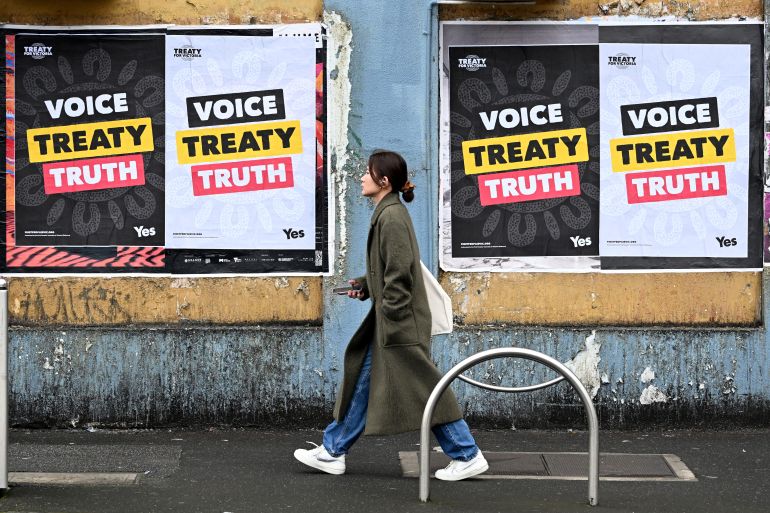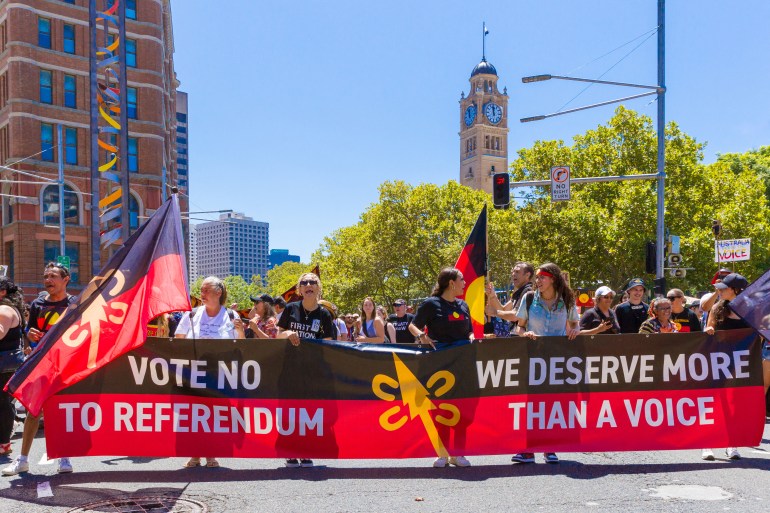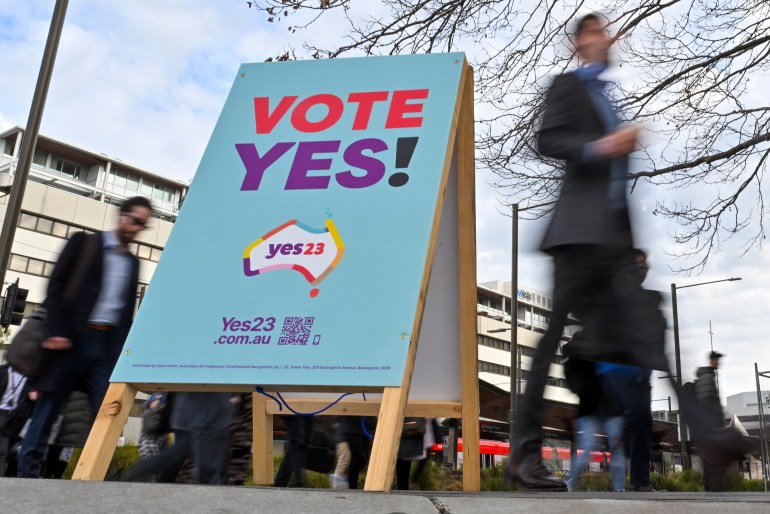Australia’s Indigenous ‘Voice’ referendum: What you need to know
Voting, which is compulsory, has been set for October 14.

Australians will vote on October 14 in a referendum that would enshrine in the nation’s constitution a mechanism for Indigenous people to advise parliament on policies that affect their lives.
Supporters say embedding what is known as the ‘Voice to Parliament’ in the constitution would recognise Indigenous people’s special place in Australian history while giving them input into government policies.
Keep reading
list of 4 itemsThousands rally across Australia in support of Indigenous reform
Australia sets stage for landmark Indigenous rights referendum
Prominent Indigenous Australian journalist quits over racism
Opponents argue it would divide Australians along racial lines without reducing the severe inequalities faced by Indigenous people.
Here are some of the key issues behind the referendum, the first in a generation.
Who are Australia’s Indigenous people?
Australia’s Indigenous people include Aboriginal and Torres Strait Islander people and they are culturally distinct from each other.
Indigenous people had lived in Australia for at least 60,000 years before the British arrived in 1788. The settlers established a colony in a land they declared “empty”, dispossessing the Indigenous people of their land, killing thousands and exposing them to new and deadly diseases.
Now numbering more than 800,000 people, and making up about 3.8 percent of the population in 2021, Indigenous people are the most disadvantaged group in the country.
Indigenous people have a life expectancy about eight years less than non-Indigenous Australians and suffer disproportionately high rates of suicide, domestic violence and imprisonment.
A third of Indigenous children were forcibly removed from their families from 1910 until the 1970s in an attempt to assimilate them into white society. The government apologised for the so-called ‘Stolen Generation‘ in 2008.
What is the Voice?
On referendum day, Australian adults will be asked to vote ‘yes’ or ‘no’ to a single question: “A Proposed Law: to alter the Constitution to recognise the First Peoples of Australia by establishing an Aboriginal and Torres Strait Islander Voice. Do you approve this proposed alteration?”
If the answer is “yes”, the constitution would be rewritten to state that the Voice “may make representations” to the Parliament and executive government “on matters relating to Aboriginal and Torres Strait Islander peoples”.
Supporters say there would be no Indigenous right of veto over government policy and lawmakers would be free to disregard the Voice’s representations.
But opponents argue the courts might interpret the Voice’s constitutional powers in unpredictable ways, creating legal uncertainty.
Proponents say the Voice would include Indigenous Australians from all eight states and territories, the Torres Strait Islands and remote and regional communities.
Members would be chosen by local Indigenous people and serve for a fixed period.

The Parliament would “have power to make laws with respect to the composition, functions, powers and procedures” of the Voice, the constitution would say.
Where did the idea come from?
Indigenous people began to be included in Australia’s census figures after a referendum to amend the constitution in 1967.
The Voice was recommended in 2017 by a group of 250 Indigenous leaders who met at Uluru, the landmark sandstone rock in central Australia that is sacred to its traditional owners.
The then-government had asked the group for advice on how the Indigenous population could be acknowledged in the constitution.
The conservative government at the time rejected the call, claiming the Voice would be seen as a “third chambre” of parliament.
The centre-left Labor Party of Prime Minister Anthony Albanese committed his government to creating the Voice after winning power in elections last year.
What are the arguments for and against the Voice?
The referendum is one of Albanese’s key issues and he has staked much of his political capital on it, arguing it would help address the longstanding inequalities faced by Indigenous communities.
The left-wing Greens party, some independent lawmakers, several welfare groups, national religious and ethno-religious groups also support the referendum.
But there are those who oppose it on both sides of the political divide.
Independent Indigenous senator Lidia Thorpe quit the Green party over concerns about the Voice proposal. She wants a treaty between the government and Indigenous people first, similar to what exists in New Zealand and Canada.
The conservative Liberal Party and the rural-based National Party remain opposed to the proposal and are urging Australians to vote no.

The Australian Electoral Commission has begun sending voters a pamphlet written by lawmakers laying out the case for voting “yes” and “no”.
The Voice would also be a first step towards Indigenous claims for repatriation and compensation.
How are constitutional amendments made in Australia?
Changing the constitution has never been easy in Australia, and more than four in five referendums fail.
A referendum to change the constitution requires what is known as a double majority – the support of most Australians nationwide plus a majority of voters in a majority of states.
Five referendums have failed because while they were supported by most Australians, they fell short of gaining majorities in at least four of the six states. Voting is compulsory.
Of the 44 referendums held since the constitution took effect in 1901, only eight have been carried and none since 1977.
How do other former British colonies handle their Indigenous communities?
First Nations people in other former British colonies continue to face marginalisation, but some countries have done better in ensuring their rights.
Canada recognises the rights of its Indigenous people under the Constitution Act 1982.
New Zealand’s 1840 Treaty of Waitangi promises to protect Maori culture. The country also created Maori seats in parliament, allowing the Indigenous population to choose to vote for candidates for these seats or participate in the general election.
Te reo Maori has been recognised as an official language and is used in schools, universities and public offices.